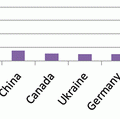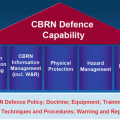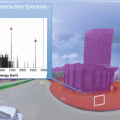Source number
Date found
Estimated activity (GBq)
1
1997-09-13
164
2
1997-09-13
126
3
1997-09-13
0.37
4
1997-09-14
0.88
5
1997-09-19
0.02
6
1997-09-19
0.02
7
1997-09-19
0.02
8
1997-09-19
0.63
9
1997-09-19
0.01
10
1997-09-20
0.02 –
The IAEA expert mission took place from 11 to 14 October 1997 to verify the dose rates at the Lilo Training Centre. The conclusion is a BSS is living document when the implementation of standards is prime responsibility of “legal” person: the first of all the previous owners of Lilo Training Centre and acting management. Unfortunately the comprehensive inventory of radioactive sources did not been transferred to national authorities by previous owners.
25.2.2 The Radiological Accident in Khaishi Region
After the accident in Lilo the Georgian Government, following the recommendations of the IAEA, initiated a programme to survey other similar sites with the aim of finding any other abandoned radioactive sources. In late July 1998, during implementation of this programme, more abandoned sources were found in the village of Matkhoji, in the region of Kutaisi, located 300 km west of Tbilisi. On 10 October 1998, two unidentified radiation sources of unknown origin with extremely high activities were discovered near the mountain village Idliani (Khaishi Region, Western Georgia). One of these sources was found without any shielding giving rise to a radiation dose rate of 50 mGy/h at a distance of 2 m from the source. On October 14, 1998, after analysis of published data about radiation sources produced in the former Soviet Union, it was assumed that the sources found near the village of Khaishi could have been part of the so-called radionuclide thermo-electric generator group. In such generators different types of radioisotopes were used, whole activity can vary from 740 GBq- to 5,550 PBq (20,000–150,000 Ci) or more. In particular, as is pointed out in the 1979 edition of “Problems of Atomic Science and Technology” by A. M. Petrosiants, it demonstrates that various types of generators were designed on the basis of different radioisotopes: 144Ce (with activity of 20,000 Ci); 90Sr-(with activity of up to 100,000 Ci) and 137Cs with activity from 50,000 to 150,000 Ci). These generators were used as sources of electrical power for radiometric devices and for navigational systems. At the request of the Georgian authorities the International Atomic Energy Agency sent a mission to assess the radiological emergency in Khaishi, to provide advice to the counterpart and to participate in the recovery operations for the reported radioactive sources. The design of the protective container for the transporting of sources was undertaken by specialists from the Institute of Physics of the Georgian Academy of Sciences. The container, containing both sources, had to comply with category two of the transport of radioactive materials regulations (the dose rate on the outer surface of the container could not exceed 0.5 mSv/h). In RTGs the strontium sources serve as a heat sources. The products of radioactive decay (Beta-particles) are captured inside the sources. They emit only “bremstrahlung”. So it was suitable to use lead as a shielding material. According to the calculations, the thickness of the protective lead layer had to be 18 cm and the total weight was estimated to be about 1,300 kg.
25.2.3 The Radiological Accident in the Tsalenjikha Region
The next (third) pair of strontium sources was found on 23 December 2001. Their existence was discovered after three inhabitants (men) from the village of Zemo Lia, Tsalenjikha region were brought to the Institute of Hematology and Transfisiology in Tbilisi [3]. Two of them had heavy radiation burns on their backs and the third one to his hands. According to the men, they were collecting wood in the forest when they came across two unknown metal objects which were hot and for some period of time they used them as a heat source to keep themselves warm.
Stay updated, free articles. Join our Telegram channel

Full access? Get Clinical Tree






